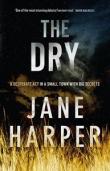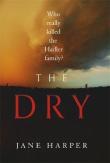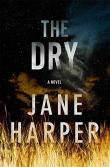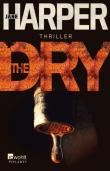AustLit
 470902978410786559.jpg
470902978410786559.jpg
Latest Issues
AbstractHistoryArchive Description
'WHO REALLY KILLED THE HADLER FAMILY?
'Luke Hadler turns a gun on his wife and child, then himself. The farming community of Kiewarra is facing life and death choices daily. If one of their own broke under the strain, well ...
'When Federal Police investigator Aaron Falk returns to Kiewarra for the funerals, he is loath to confront the people who rejected him twenty years earlier. But when his investigative skills are called on, the facts of the Hadler case start to make him doubt this murder-suicide charge.
'And as Falk probes deeper into the killings, old wounds are reopened. For Falk and his childhood friend Luke shared a secret ... A secret Falk thought long-buried ... A secret which Luke's death starts to bring to the surface ...' (Publication summary)
Adaptations
-
form
y
 The Dry
( dir. Robert Connolly
)
Australia
:
Made Up Stories
,
2021
13199545
2021
single work
film/TV
crime
The Dry
( dir. Robert Connolly
)
Australia
:
Made Up Stories
,
2021
13199545
2021
single work
film/TV
crime
'When Aaron Falk returns to his drought ravaged town in Victoria to attend his best mate’s funeral, he finds himself drawn into a web of lies and murder, which forces him to confront the guilty secrets of his own past. Based on the novel of the same name, written by Jane Harper.'
Source: Screen Australia funding approvals.
Notes
-
Reports in late 2015 indicated that film rights to the then-unpublished novel had been bought by the film company run by Reese Witherspoon and Bruna Papandrea. The film was funded by Screen Australia for development by Papandrea's production company in August 2017.
-
Dedication: To my parents, Mike and Helen, who always read to me.
-
Number 3 on the Better Reading's 2001 Top 100
Publication Details of Only Known VersionEarliest 2 Known Versions of
Other Formats
- Large print.
- Dyslexic edition.
- Sound recording.
- Sound recording (German)
Works about this Work
-
‘Little Difference between a Carcass and a Corpse’ : Ecological Crises, the Nonhuman and Settler-Colonial Culpability in Australian Crime Fiction
2021
single work
criticism
— Appears in: JASAL , vol. 21 no. 2 2021;'In 1997, Stephen Knight described Australian crime fiction as a genre that is ‘thriving but unnoticed’ (Continent of Mystery 1). While in recent years Australian crime fiction has gained more attention amongst both academics and reviewers, it is still missing from an area of study in which I believe it demands more notice—that is, ecocritical discussions of Australian fiction. In this paper, I investigate the idea of Australian crime fiction as a largely underexplored representation of the modern environmental crisis, discussing how modern Australian crime fiction often portrays the troubling relationship between human violence and the settler-colonial decimation of Australia’s natural environments and nonhuman animals. Such a relationship indirectly alludes to the impact of a changing climate on Australian communities and ecosystems and suggests that popular genre fiction can contribute in profound ways to broader environmental considerations. With this ecocritical framework in mind, this paper analyses the representation of drought, bushfire and the nonhuman in Jane Harper’s The Dry (2016) and Chris Hammer’s Scrublands (2018), and what such texts reveal to readers about the criminal nature of anthropogenic climate change and the settler-colonial destruction of Australian habitats.' (Publication abstract)
-
Our Twisted Red Heart
2019
single work
column
— Appears in: The Weekend Australian , 2 November 2019; (p. 22)'Why has Australian ‘rural noir’ become so popular? Crime novelist Garry Disher investigates'
-
‘Like Volcanoes on the Ranges’ : How Australian Bushfire Writing Has Changed with the Climate
2019
single work
column
— Appears in: The Conversation , 13 November 2019;'Bushfire writing has long been a part of Australian literature.
'Tales of heroic rescues and bush Christmases describe a time when the fire season was confined only to summer months and Australia’s battler identity was forged in the flames.' (Introduction)
-
Uncertain Seasons in the El Niño Continent : Local and Global Views
2019
single work
criticism
— Appears in: Anglica : An International Journal of English Studies , vol. 28 no. 3 2019; (p. 7-19)'As global climate change shifts seasonal patterns, local and uncertain seasons of Australia have global relevance. Australia’s literature tracks extreme local weather events, exploring ‘slow catastrophes’ and ‘endurance.’ Humanists can change public policy in times when stress is a state of life, by reflecting on the psyches of individuals, rather than the patterns of the state. ‘Probable’ futures, generated by mathematical models that predict nature and economics, have little to say about living with extreme weather. Hope is not easily modelled. The frameworks that enable hopeful futures are qualitatively different. They can explore the unimaginable by offering an ‘interior apprehension.’' (Publication abstract)
-
y
 The Dry by Jane Harper
Melbourne
:
CAE Book Group
,
2019
16681975
2019
single work
criticism
The Dry by Jane Harper
Melbourne
:
CAE Book Group
,
2019
16681975
2019
single work
criticism
-
Write Words Win
2016
single work
review
— Appears in: The Courier-Mail , 27 May 2016; (p. 36)
— Review of The Dry 2016 single work novel 'Books When Jane Harper put her debut novel up for an award she hoped for feedback, but she won, and scored a film deal. First-time authors often talk about the “journey” of writing their debut novel. Frequently it involves a love of story-telling as a child, endless journal writing, pages and pages of short stories, first drafts and the seemingly never-ending struggle of getting noticed by a publisher.None of that is the experience of Jane Harper, whose first novel, The Dry, is released on Wednesday.' -
Small-Town Secrets
2016
single work
review
— Appears in: The West Australian , 7 June 2016; (p. 6)
— Review of The Dry 2016 single work novel ; Out of the Ice 2016 single work novel -
Unpleasantville
2016
single work
review
— Appears in: Australian Book Review , June-July no. 382 2016; (p. 51)
— Review of The Dry 2016 single work novel -
Outback Murder with Mythic Overtones
2016
single work
review
— Appears in: The Sydney Morning Herald , 11-12 June 2016; (p. 24) The Saturday Age , 11-12 June 2016; (p. 24)
— Review of The Dry 2016 single work novel -
The Dry Review: Jane Harper's Hot Crime Debut Is Mythic and Valiant
2016
single work
review
— Appears in: Brisbane Times , 9 June 2016;
— Review of The Dry 2016 single work novel 'Every now and then an Australian crime novel comes along to stop your breath and haunt your dreams. The Broken Shore by Peter Temple was one, Bitter Wash Road by Garry Disher another. Both are books that capture something profound about the Australian landscape and the people who inhabit it. Both are not just great crime fiction, but great Australian novels. The Dry by Jane Harper is another. ...' -
Rural Murder Manuscript Wins Journalist $15,000 Prize
2015
single work
column
— Appears in: The Sydney Morning Herald , 26 May 2015; 'Jane Harper has taken a significant stride in the footsteps of some of Australia's most successful recent authors by winning this year's Victorian Premier's Literary Award for her unpublished manuscript, The Dry...' -
Adelaide Film Scene Produces the Goods
2015
single work
column
— Appears in: The Advertiser , 29 December 2015; (p. 13) -
Jane Sullivan Laments the Lack of Australians in a Hymn to Female Crime Writers
2016
single work
column
— Appears in: Brisbane Times , 29 July 2016 2016; 'Raymond Chandler famously advised fellow crime writers that when in doubt, they should have a man come through a door with a gun in his hand. When today's crime writers are in doubt, they have a woman come through the door with a passive-aggressive zinger on her lips. ...' -
Crime Q and A in the Suburbs
2016
single work
column
— Appears in: Good Reading , September 2016; (p. 22) 'gr reader CLIVE HODGES recently attended a Q&A session at Riverbend Books in the Brisbane suburb of Bulimba with Melbourne writer Jane Harper, author of The Dry. Jane talked about deadlines, a movie adaptation and one attendee asked if the book would pass the Bechdel Test.' -
Horror in the Outback : Jane Harper, Charlotte Wood and the Landscape of Fear
2016
single work
column
— Appears in: The Guardian Australia , 19 October 2016; 'From Hanging Rock to Bitter Wash Road, the Australian bush has long provided writers with a backdrop of terror. A new wave of crime fiction is taking it up a notch.'
Awards
- 2018 winner Barry Award — Best First Novel
- 2018 winner British Book Awards — Crime and Thriller Book of the Year
- 2018 nominated Anthony Awards — Best First Novel
- 2018 longlisted International IMPAC Dublin Literary Award
- 2017 shortlisted Australian Booksellers Association Awards — Booksellers Choice Award
- Victoria,






